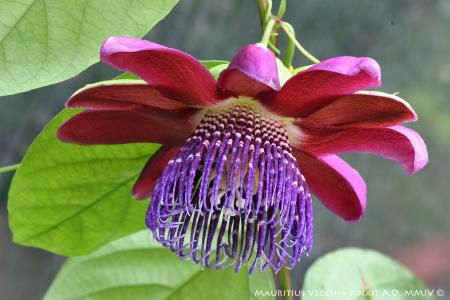
SUBGENUS: passiflora
SUPERSECTION: laurifolia
SERIES: laurifoliae
GEOGRAPHICAL DISTRIBUTION OR ORIGIN:
Peru
MINIMUM TEMPERATURE: 5 °C
IDEAL MINIMUM TEMPERATURE: 10 °C
SYNONYMS: P. alata ‘Ruby Glow’
ETYMOLOGY: From the Latin 'phoeniceus', purple red, characteristic color of the flowers.
DESCRIPTION:
I can only imagine the lengthy discussions botanists had at the time when seeking to establish whether P. phoenicea was a separate species rather than a form of P. alata (P. alata 'Ruby Glow') with which it has much in common. The differences, however, are substantial: the more contrasting colour of the flowers, the shape of the leaves, the glands of the petiole, and other small but important details. Furthermore, the thesis that considers P. phoenicea a distinct species (a very ancient thesis, since it dates back to 1603) is supported by the fact that this plant was found in the wild. Angiolo Pucci, in the 'Encyclopedia Orticola Illustrata' (Hoepli, 1915) mentions it as a species, while attributing it the synonym of 'P. alata brasiliana'.
Its flowering is spectacular, not only because of the showy beauty of the purple and violet-red flowers, but also because it produces so many of them in continuous succession, creating intense patches of colour along its branches.
The corolla, with a diameter of about 12-14 cm, is made up of sepals and dark red petals with purple hues. The corona protrudes forward as if to hide the androgynophore and to emphasise the corolla itself. The filaments, arranged in two series, are very long, up to more than 5 cm, and are coloured by alternating dark violet and white bands. At the ends they taper and tend to curl. The flower is substantial in all its parts, communicating a feeling of strength: the petals and sepals are fleshy, the corona equally vigorous and robust.
The stems have a square cross-section with small wings at the edges and often take on a reddish colour. The leaves are whole, broadly ovate and with smooth margins. At the junction with the petiole, there are two large yellow glands, unlike P. alata which has at least 2-3 pairs, smaller and colourless.
It produces large, ovoid fruits, yellow when ripe.
P. phoenicea, although able to bear temperatures very close to 0°C for short periods, is cultivated in pots. It is, therefore, to be considered a houseplant or for winter shelter in a warm greenhouse. However, I believe that in Liguria, Sicily and other areas with a mild winter it has a certain chance of acclimatisation outdoors.
To obtain a more abundant flowering and a more compact growth, a sunny exposure is recommended. It is necessary to use pots of at least 25-30 cm filled with good-quality multipurpose soil. Fertilisation with Osmocote is necessary since P. phoenicea, once acclimatised, grows and branches quickly and could suffer from nutrient deficiencies.
Propagation
from cuttings is preferable to reproduction from seed due to the slow growth of
young plants.